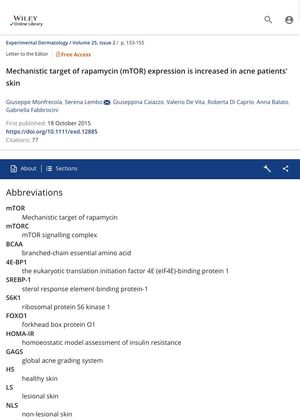Mechanistic Target of Rapamycin (mTOR) Expression Is Increased in Acne Patients' Skin
October 2015
in “
Experimental Dermatology
”

TLDR Acne patients have higher levels of mTOR in their skin, which could be linked to future metabolic disease.
The study from 7 years ago, titled "Mechanistic target of rapamycin (mTOR) expression is increased in acne patients' skin", investigated the role of mTOR in acne. The study involved 10 acne patients and 10 controls. The researchers found that mTOR gene expression was significantly increased in both lesional and non-lesional skin from acne patients compared to healthy controls. This increase was not related to acne severity or body mass index, but was significantly correlated with the homoeostatic model assessment of insulin resistance (HOMA-IR). The study also found that P-S6K1, a downstream regulator activated by mTORC1, was gradually increased in non-lesional and lesional samples compared to healthy skin. This could explain increased lipogenesis in acne. The researchers concluded that mTOR could play a role in acne pathogenesis and could potentially be a marker of future metabolic disease. However, they noted that this was a preliminary study with a small number of patients and further research was needed.

